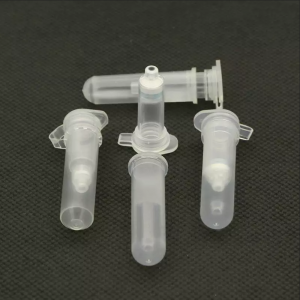Nucleic acid is divided into deoxyribonucleic acid (DNA) and ribonucleic acid (RNA), among which RNA can be divided into ribosomal RNA (rRNA), messenger RNA (mRNA) and transfer RNA (tRNA) according to different functions.
DNA is mainly concentrated in the nucleus, mitochondria and chloroplasts, while RNA is mainly distributed in the cytoplasm.
Because purine bases and pyrimidine bases have conjugated double bonds in nucleic acids, nucleic acids have the characteristics of ultraviolet absorption. The ultraviolet absorption of DNA sodium salts is around 260nm, and its absorbance is expressed as A260, and it is at the absorption trough at 230nm, so ultraviolet spectroscopy can be used. Nucleic acids are quantitatively and qualitatively determined by a luminometer.
Nucleic acids are ampholytes, which are equivalent to polyacids. Nucleic acids can be dissociated into anions by using neutral or alkaline buffers, and placed in an electric field to move toward the anode. This is the principle of electrophoresis.
Nucleic acid extraction and purification principles and requirements
1. Ensure the integrity of nucleic acid primary structure
2. Eliminate the contamination of other molecules (such as excluding RNA interference when extracting DNA)
3. There should be no organic solvents and high concentrations of metal ions that inhibit enzymes in nucleic acid samples
4. Reduce macromolecular substances such as proteins, polysaccharides and lipids as much as possible
Nucleic acid extraction and purification method
1. Phenol/chloroform extraction method
It was invented in 1956. After treating the cell broken liquid or tissue homogenate with phenol/chloroform, the nucleic acid components, mainly DNA, are dissolved in the aqueous phase, lipids are mainly in the organic phase, and proteins are located between the two phases.
2. Alcohol precipitation
Ethanol can eliminate the hydration layer of nucleic acid and expose the negatively charged phosphate group, and positively charged ions such as NA﹢ can combine with the phosphate group to form a precipitate.
3. Chromatographic column method
Through the special silica-based adsorption material, DNA can be specifically adsorbed, while RNA and protein can pass through smoothly, and then use high salt and low pH to bind nucleic acid, and elute with low salt and high pH to separate and purify nucleic acid.
4. Thermal cracking alkali method
Alkaline extraction mainly uses the topological differences between covalently closed circular plasmids and linear chromatin to separate them. Under alkaline conditions, denatured proteins are soluble.
5. Boiling pyrolysis method
The DNA solution is heat-treated to take advantage of the properties of linear DNA molecules to separate DNA fragments from the precipitate formed by denatured proteins and cellular debris by centrifugation.
6. Nanomagnetic beads method
Using nanotechnology to improve and modify the surface of superparamagnetic nanoparticles, superparamagnetic silicon oxide nano-magnetic beads are prepared. The magnetic beads can specifically recognize and efficiently bind to nucleic acid molecules on a microscopic interface. Using the superparamagnetic properties of silica nanospheres, under the action of Chaotropic salts (guanidine hydrochloride, guanidine isothiocyanate, etc.) and an external magnetic field, DNA and RNA were isolated from blood, animal tissue, food, pathogenic microorganisms and other samples .
Post time: Mar-18-2022




